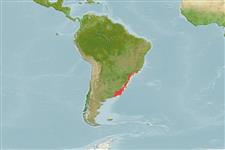Classification / Names
Common names from other countries
Main reference
Size / Weight / Age
Max length : 34.4 cm TL male/unsexed; (Ref. 111977)
Environment
Marine; pelagic-neritic
Climate / Range
Subtropical, preferred 18°C (Ref. 107945); 22°S - 38°S, 60°W - 42°W (Ref. 188)
Distribution
Short description
Dorsal
spines
(total): 0;
Anal
spines: 0. Scutes apparent along belly. Upper jaw with distinct median notch. Pectoral fin tip short of pelvic fin base by width of 3 to 7 scales; pelvic fin with oblique and almost straight hind margin. Pre-dorsal scales modified; scales on back and above base of anal fin not markedly smaller than rest. A black spot behind gill opening, but none along flank.
IUCN Red List Status (Ref. 115185)
Threat to humans
Harmless
Human uses
Fisheries: commercial
More information
ReferencesAquacultureAquaculture profileStrainsGeneticsAllele frequenciesHeritabilityDiseasesProcessingMass conversion
Tools
Special reports
Download XML
Internet sources
Estimates of some properties based on models
Phylogenetic diversity index
PD50 = 0.5156 many relatives (e.g. carps) 0.5 - 2.0 few relatives (e.g. lungfishes)
Trophic Level
2.8 ±0.31 se; Based on food items.
Resilience
High, minimum population doubling time less than 15 months (Assuming tm=1)
Vulnerability
Low to moderate vulnerability (26 of 100)
Price category
